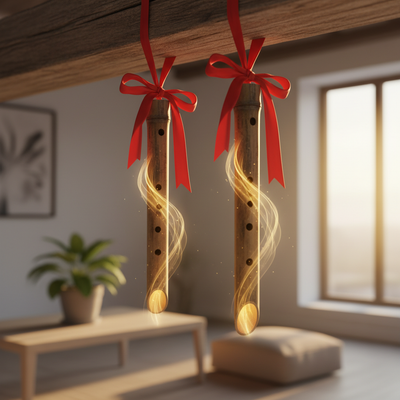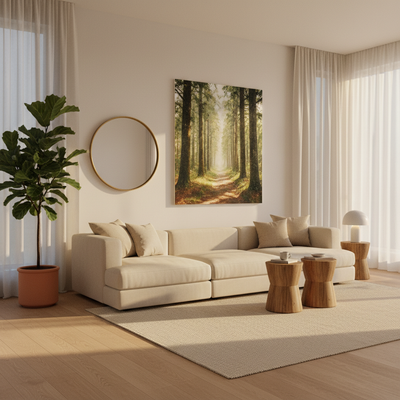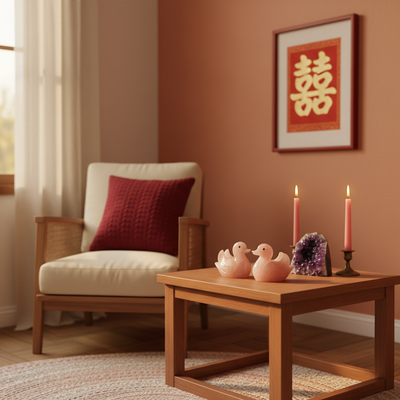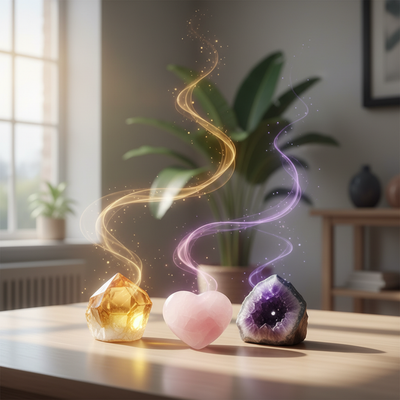Your Bedroom is Your Safe Space
In a busy world full of noise and stress, your bedroom should be the one place where you can truly relax, rest, and find peace. It's more than just a place to sleep; it's your personal safe space for rest and renewal. If you're feeling tired, sleeping badly, or feeling like something is off in your personal life, the problem might be in the energy of your room. This guide gives you a clear, step-by-step plan to change your room using the proven ideas of feng shui furniture for the bedroom. We will show you how to get better sleep, improve relationships, and feel truly refreshed. The most important thing is where you put your bed, so we will start there before building a complete plan for your peaceful retreat.
Basic Feng Shui Ideas

To set up your bedroom well, it helps to understand the basic ideas that guide our suggestions. This isn't about following random rules; it's about learning why certain placements and choices create a better environment. This knowledge helps you make smart decisions for your own space.
Understanding Qi
At the center of Feng Shui is Qi (said like "chee"), the life energy that flows through all things, including your home. In a bedroom, we want this energy to move gently and smoothly, like a calm, winding stream. This helps healing, rest, and peace. When Qi gets blocked, it creates stuck energy, like a muddy pond, leading to feelings of being trapped or tired. On the other hand, if Qi moves too fast, like a rushing river, it can cause restlessness and worry. Our goal with furniture placement is to encourage a soft, caring flow of Qi.
The Command Position
The most important rule for your bedroom is the Command Position. This idea is essential for creating a sense of safety and peace. It means placing your bed so that you can see the door to the room without being directly in line with it. Mentally, this position puts you in control of your space and your life. You can see who or what is coming in, removing hidden worry and letting your nervous system fully relax. When you are not in command, you are more easily scared and your body stays in a subtle state of alert, preventing deep, healing sleep.
Yin and Yang Balance
Feng Shui is also about balancing the opposite forces of Yin and Yang. Yin represents calm, quiet, dark, and soft energies, while Yang represents active, bright, hard, and loud energies. A bedroom should be mostly a Yin space to encourage rest and thinking. However, a room that is 100% Yin can feel lifeless and stuck. Therefore, we aim for a foundation of Yin with small Yang touches to keep a gentle, living energy.
| Yin (Rest) Qualities | Yang (Active) Qualities |
|---|---|
| Soft fabrics, plush rugs | Hard surfaces, metal finishes |
| Curved lines, flowing shapes | Sharp angles, geometric patterns |
| Dark, muted, earthy colors | Bright, vibrant colors |
| Low, soft lighting | Bright, direct lighting |
| Quiet, stillness | Sound, electronics |
The Heart of the Room
Your bed is the most important piece of furniture in the room, as it is directly connected to your personal energy and well-being. Getting its Feng Shui right is the first and most powerful step toward creating your safe space. We'll break down exactly how to position and choose your bed for the best rest and support.
Golden Rules of Placement
Follow these important rules to anchor your room's energy correctly. Even if you can only apply one or two, you will notice a difference.
-
Rule 1: The Command Position in Practice. Position your bed diagonally across from the bedroom door. You should have a clear view of the entrance from your pillow, but your feet should not point directly out the door. In a square room, this is often a corner placement. In a rectangular room, it's usually on the long wall farthest from the door.
-
Rule 2: The Power of a Solid Headboard. Your headboard represents support and stability in your life. A solid, sturdy headboard, preferably made of wood or covered fabric, provides strong backing that creates a sense of safety while you sleep. Avoid beds with no headboard, as this can lead to feelings of instability. Also, stay away from headboards with slats or bars, as they are symbolically "trapping" and can create disruptive energy behind your head.
-
Rule 3: Have a Solid Wall Behind You. Just as the headboard provides support, the wall it rests against offers a larger sense of backing. Always place your bed against a solid wall. Avoid placing your bed directly under a window. Sleeping with a window behind your head can drain your personal energy and leave you feeling unsafe, as Qi can easily enter and exit, creating an unsettled environment.
-
Rule 4: Avoid the "Coffin Position." This refers to lying in bed with your feet pointing directly in line with the door. This is considered the worst position in Feng Shui as it copies the way dead people are carried out of a room, and it is thought to drain your life force energy while you sleep. If your room's layout makes this unavoidable, the best fix is to place a solid footboard or a piece of furniture, like a bench or a low chest, at the end of the bed to create a protective barrier.
What's Above and Below
The energy affecting you isn't just horizontal; it's also vertical. Pay close attention to what is directly above and below your bed.
-
Above: Sleeping under heavy overhead objects creates oppressive energy, known as "Sha Qi." This includes heavy ceiling beams, chandeliers, or even ceiling fans directly over the bed. This constant downward pressure can lead to headaches, stress, and a feeling of being weighed down. If you cannot move the bed, a simple fix is to hang a canopy or drape fabric to soften and spread out the oppressive energy.
-
Below: The space under your bed must be kept clear to allow Qi to move freely around you as you sleep. We strongly advise against using this area for storage. It should be open and clean. We often find that clients who report restless sleep are storing everything from old shoes to stressful work documents under their bed. Clearing this space is one of the fastest ways we see to improve sleep quality. If you absolutely must use this space for storage, limit it to soft, sleep-related items only, such as spare blankets, pillows, and linens. Never store emotionally charged items like old letters, weapons, or anything related to work.
Choosing the Right Bed
When selecting a bed frame and headboard, consider the material, shape, and size. Wood is generally the best material as its energy is nourishing and supportive. Covered headboards are also excellent as they bring a soft, Yin quality. Avoid metal frames and headboards when possible, as their conductive nature can amplify electromagnetic fields and create a harsh, Yang energy. Choose a bed with soft, curved lines over one with sharp, angular corners. The size of the bed should be proportional to the room—a bed that is too large can make a room feel cramped and stuck, while one that is too small can feel ungrounded.
The Supporting Cast
Once your bed is perfectly placed, it's time to arrange the other essential furniture to support and enhance the room's harmonious flow. Each piece has a role to play in the overall energy of your safe space.
Bedside Guardians
Nightstands, or bedside tables, are essential for creating balance. It is highly recommended to have two nightstands, one on each side of the bed, even if you are single. This creates energetic balance and symbolically makes space for a partner (or supports equality in an existing relationship). Your nightstands should be of a similar size and style to promote harmony. Ideally, their height should be roughly level with the top of your mattress—if they are too high, they can create a sense of hidden threat, and if they are too low, they can be unsupportive. Choose tables with rounded corners to soften the energy next to where you sleep.
Wardrobes and Dressers
Wardrobes, armoires, and dressers house our belongings and play a crucial role in containing energy. Their placement is important. Avoid positioning large, tall pieces of furniture where they create a "sharp edge" or "poison arrow" pointing directly at the bed. These sharp corners project aggressive energy (Sha Qi) toward you while you rest. If unavoidable, you can soften the edge by hanging a draping plant or a piece of fabric from the corner. It is also vital to keep wardrobe and dresser doors closed at night to contain the energy of your clothes and prevent a sense of chaotic openness. A well-organized interior is just as important; a cluttered closet creates stuck Qi that can subtly affect the room's atmosphere.
The Mirror Dilemma
Mirror placement is one of the most talked-about topics in bedroom Feng Shui, and for good reason. The primary rule is simple: mirrors should not reflect the bed. A mirror's energy is very active (Yang) and it doubles whatever it reflects. When a mirror reflects a sleeping person, it is believed to bounce energy around, disrupting sleep and causing restlessness. Some schools of thought also suggest that it can symbolically invite a third party into a relationship, creating unfaithfulness. The safest places for a mirror are on a wall that does not face the bed or, even better, on the inside of a closet door, where it can be closed away at night.
Desks and Electronics

Your bedroom's primary purpose is rest and intimacy. Work and stress are active, Yang energies that directly conflict with this purpose. For this reason, we strongly advise against having a desk or exercise equipment in the bedroom. If your living situation makes this unavoidable, you must create a clear energetic separation. Place the desk as far from the bed as possible. When you are finished working, cover the entire desk and computer with a beautiful cloth. This simple act symbolically puts the work "to sleep" and shifts the room's energy from work to rest. Similarly, keep all other electronics to a minimum and turn them off completely at night.
Beyond Placement: Style and Material
True mastery of bedroom Feng Shui goes beyond simply where you put things. The very essence of your furniture—its material, shape, and color—carries a specific energetic quality. By understanding these subtle influences, you can fine-tune your space for the best harmony, moving from good Feng Shui to great Feng Shui.
The Five Elements
In Feng Shui, the universe is made up of Five Elements: Wood, Fire, Earth, Metal, and Water. Each element has a corresponding energy, color, shape, and material. A balanced room will contain a harmonious blend of these elements, with a focus on those that promote rest.
| Element | Corresponding Materials | Shapes | Energetic Quality |
|---|---|---|---|
| Wood | Wood, plants, cotton | Rectangular, columnar | Growth, vitality, flexibility |
| Fire | Leather, wool, candles | Triangular, pointed | Passion, expression, activity |
| Earth | Ceramics, pottery, stone | Square, flat | Stability, nourishment, grounding |
| Metal | Metal, natural crystals | Round, oval, arched | Clarity, precision, focus |
| Water | Glass, mirrors, silk | Wavy, asymmetrical, flowing | Flow, intuition, tranquility |
Yin-Yang Balance in Furniture
We can use the Five Elements to create the perfect Yin-Yang balance in the bedroom.
For a Restful (Yin) Space, focus on furniture and decor that embody the Earth and Wood elements. Choose pieces that are lower to the ground, have soft, curved lines, and are made from natural materials. A solid wood bed frame (Wood element) with a covered headboard, paired with ceramic lamps (Earth element) and cotton bedding (Wood element), creates a deeply grounding and nurturing environment. The shapes should be mostly square (Earth) for stability and flowing (Water) for ease, avoiding too many sharp, triangular (Fire) or rigid rectangular (Wood) forms.
To add subtle Yang for balance, introduce small touches of the Metal and Fire elements. This prevents the room from feeling too heavy or sluggish. A pair of small metal-based lamps (Metal element) can bring clarity. A single piece of art with warm, vibrant tones (Fire element) can add a touch of passion without being overstimulating. The key is for these Yang elements to be accents, not the main features.
A Note on Used Furniture
Bringing second-hand or antique furniture into your personal safe space requires special consideration. These pieces carry the "predecessor energy" of their previous owners. If the previous owner was happy and healthy, the piece might carry positive Qi. However, if they were ill, sad, or stressed, that leftover energy can linger and affect your space. This is especially critical for the bed itself. We always advise clients to be careful. Before bringing any used furniture into your bedroom, it's essential to cleanse it energetically. You can do this by wiping it down with salt water, leaving it in the sun and fresh air for a full day, or smudging it with sage or palo santo to clear any lingering energetic imprints.
Real-World Feng Shui
Theory is important, but seeing how these principles transform a real space is where the magic becomes real. This is a core part of our work, and we've seen firsthand how targeted adjustments can change lives.
The Challenge: Restless Nights
A client approached us feeling exhausted and disconnected from their partner. They reported chronic insomnia, anxiety, and a growing sense of strain in their relationship. Upon assessing their bedroom, the issues were immediately clear. Their bed was positioned directly under a heavily sloped ceiling, creating oppressive energy. It was also in the "coffin position," with their feet aimed directly at the door. To make matters worse, a large, ornate mirror on the opposite wall directly reflected the bed, and an open-style metal shelving unit served as a chaotic, exposed wardrobe. The room felt energetically active and unsafe.
The QI FLOW Solution
The QI FLOW team developed a step-by-step plan to radically shift the room's energy. Our recommendations for their feng shui furniture bedroom layout were precise and based on the core principles we've discussed.
-
Step 1: We immediately repositioned the bed. We moved it against the solid, uninterrupted wall, placing it in the Command Position. This single change removed the oppressive feeling from the sloped ceiling and the vulnerability of the coffin position, providing an instant sense of stability.
-
Step 2: The bed had a minimal, open-bar metal headboard. We had them replace it with a solid, covered headboard to enhance the feeling of support and introduce a soft, Yin quality.
-
Step 3: The large mirror was moved to the wall perpendicular to the bed, where it no longer reflected them while they slept. It now reflected natural light from a window, brightening the room without disrupting their rest.
-
Step 4: The open metal shelving was the final major issue. We replaced it with a beautiful wooden wardrobe with solid doors. This contained the visual clutter and replaced the harsh, active Metal energy with the grounding, nourishing energy of Wood.
The Result: Restored Harmony
The transformation was profound. Within two weeks, the client reported sleeping through the night for the first time in months. They described the room as feeling "calm," "quiet," and "like a hug." The feeling of anxiety had disappeared, replaced by a sense of safety. Most importantly, they noted that the tension in their relationship had eased, and they felt more connected and intimate with their partner. This case study is a powerful testament to how strategic feng shui furniture bedroom adjustments are not just aesthetic but can have a deep and lasting impact on your well-being.
Final Checklist for Your Makeover
Starting a Feng Shui transformation can feel overwhelming. Use this simple checklist to guide you through the most important changes. Focus on one section at a time.
Bed and Foundation
- [ ] Bed is in the Command Position (can see the door, not in line with it).
- [ ] A solid headboard is securely attached to the bed.
- [ ] A solid wall is behind the headboard (not a window).
- [ ] The under-bed area is clear of all clutter.
Furniture and Flow
- [ ] A pair of balanced nightstands flank the bed.
- [ ] No mirrors are reflecting the bed from any angle.
- [ ] Wardrobe and dresser doors are kept closed.
- [ ] No "poison arrows" from sharp furniture corners are aimed at the bed.
Energy and Atmosphere
- [ ] Work or exercise equipment is removed or fully concealed at night.
- [ ] The room is decluttered and feels spacious and easy to move through.
- [ ] There is a good balance of Yin (soft, curved, earthy) and Yang (small, bright, metallic) elements.
Crafting Your Personal Haven
Remember, creating a Feng Shui bedroom is a personal journey, not a rigid set of rules that demand perfection. It's about tuning into your own space and sensing what feels right for you. Start with one or two changes that resonate the most—perhaps clearing the clutter from under your bed or moving a mirror. Notice the shift in how you feel, how you sleep, and how you move through your day. Your bedroom has the potential to be a powerful source of healing and support. By applying these principles, you are consciously crafting a personal haven that truly nurtures your health, your relationships, and your spirit.







